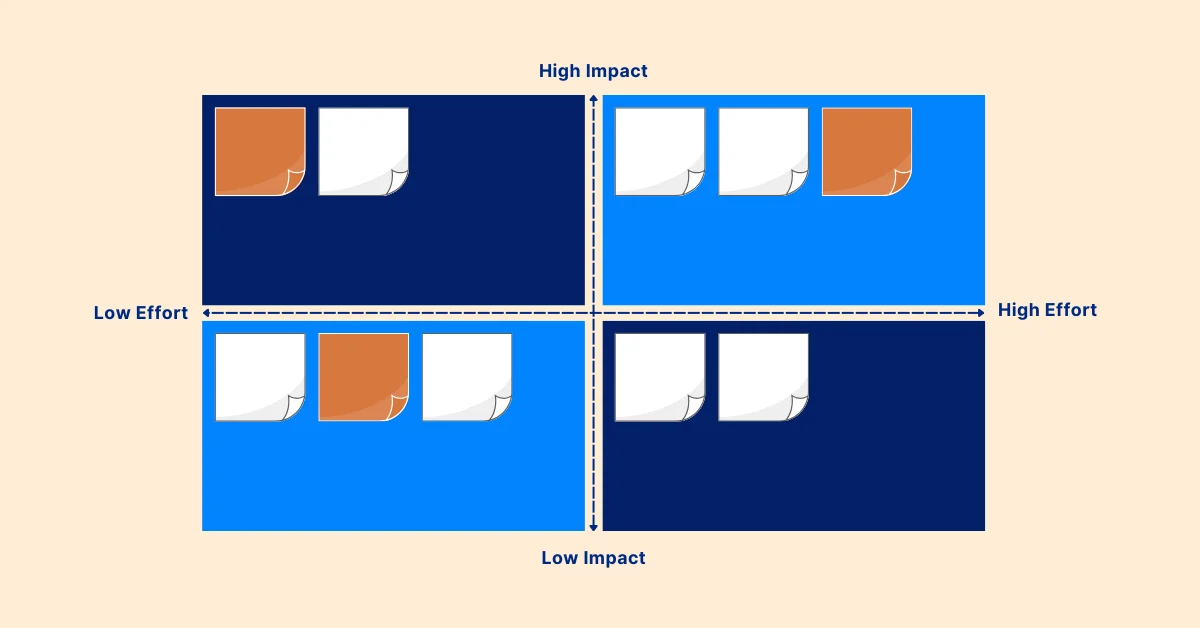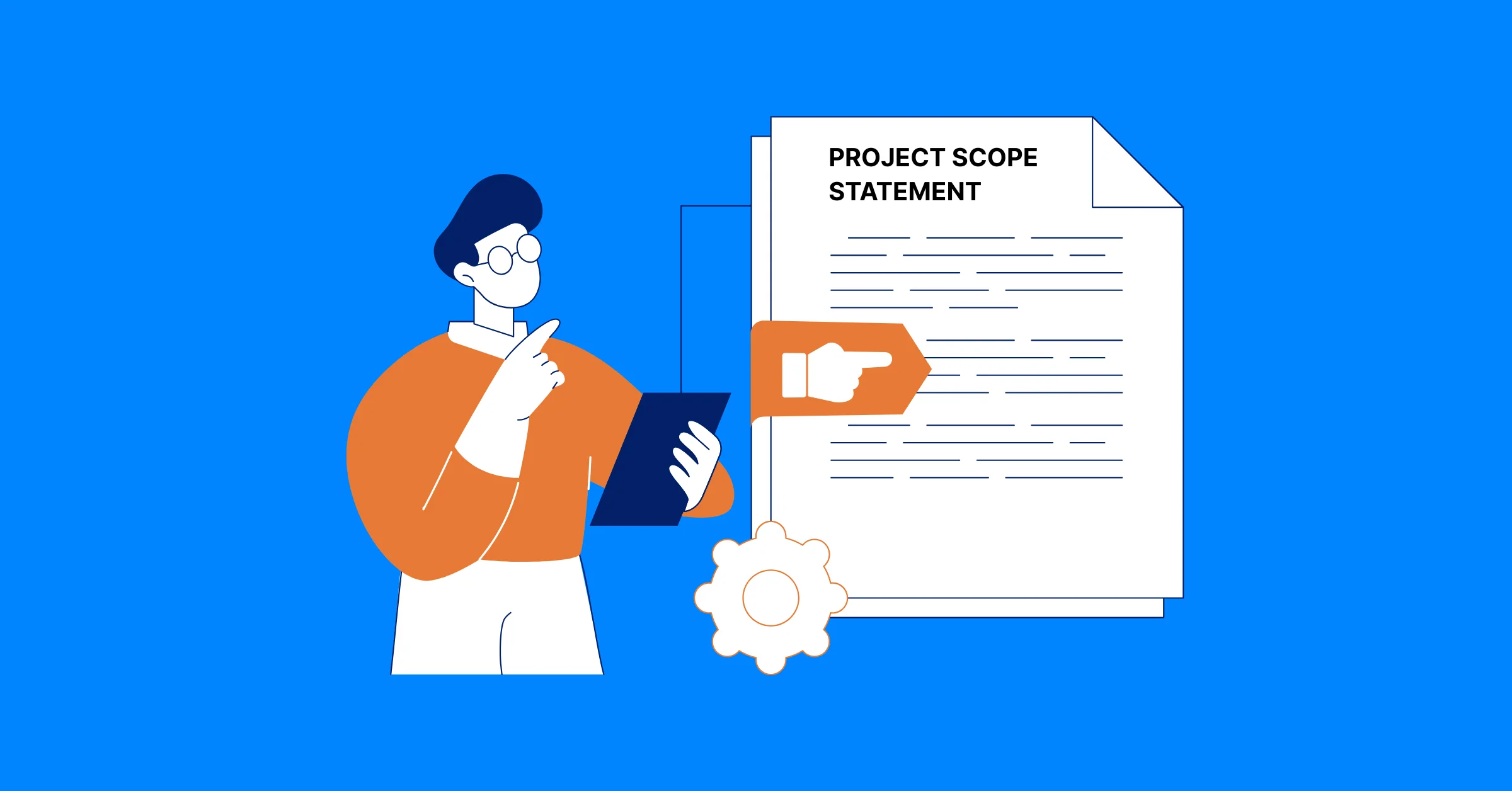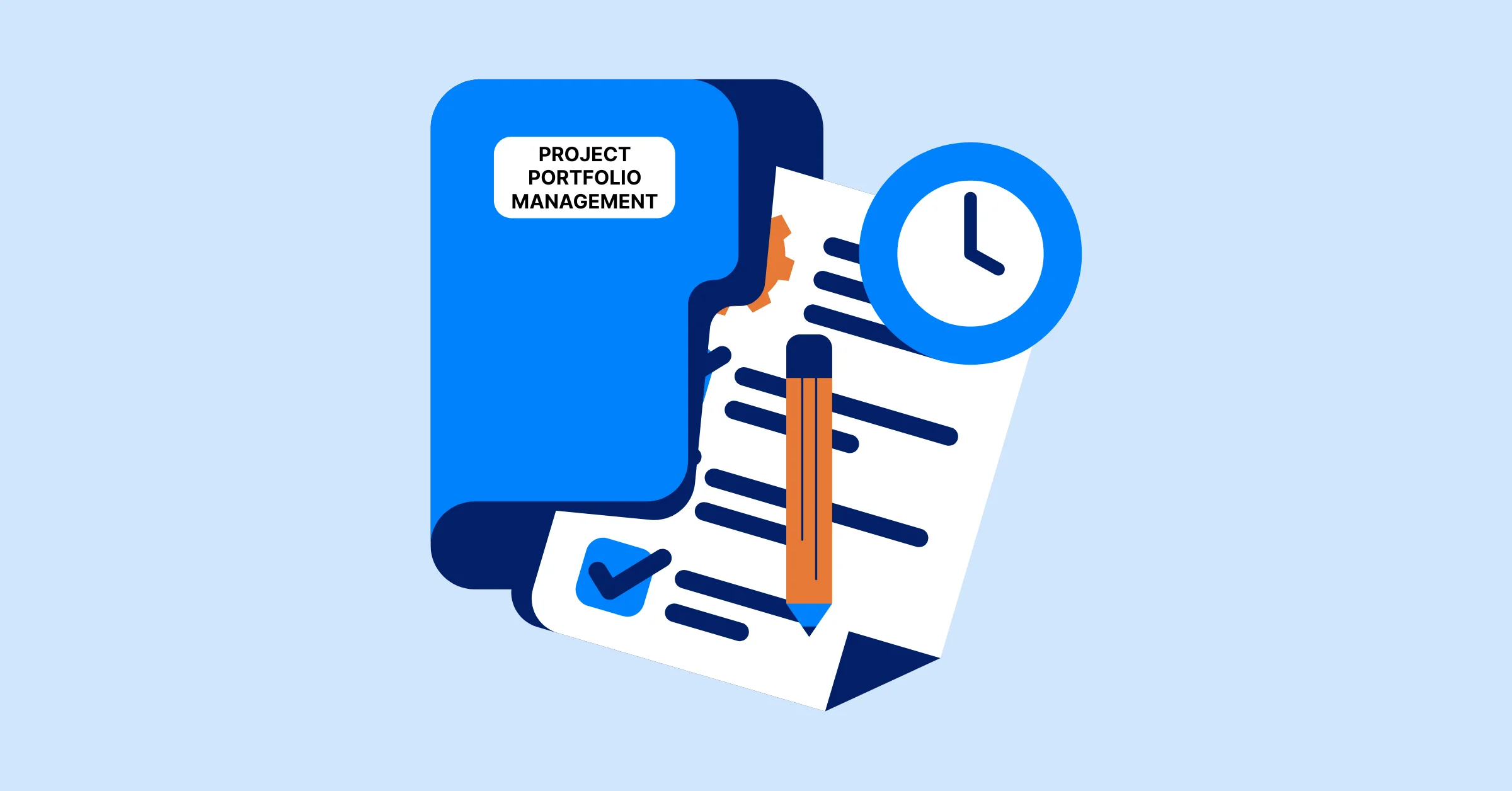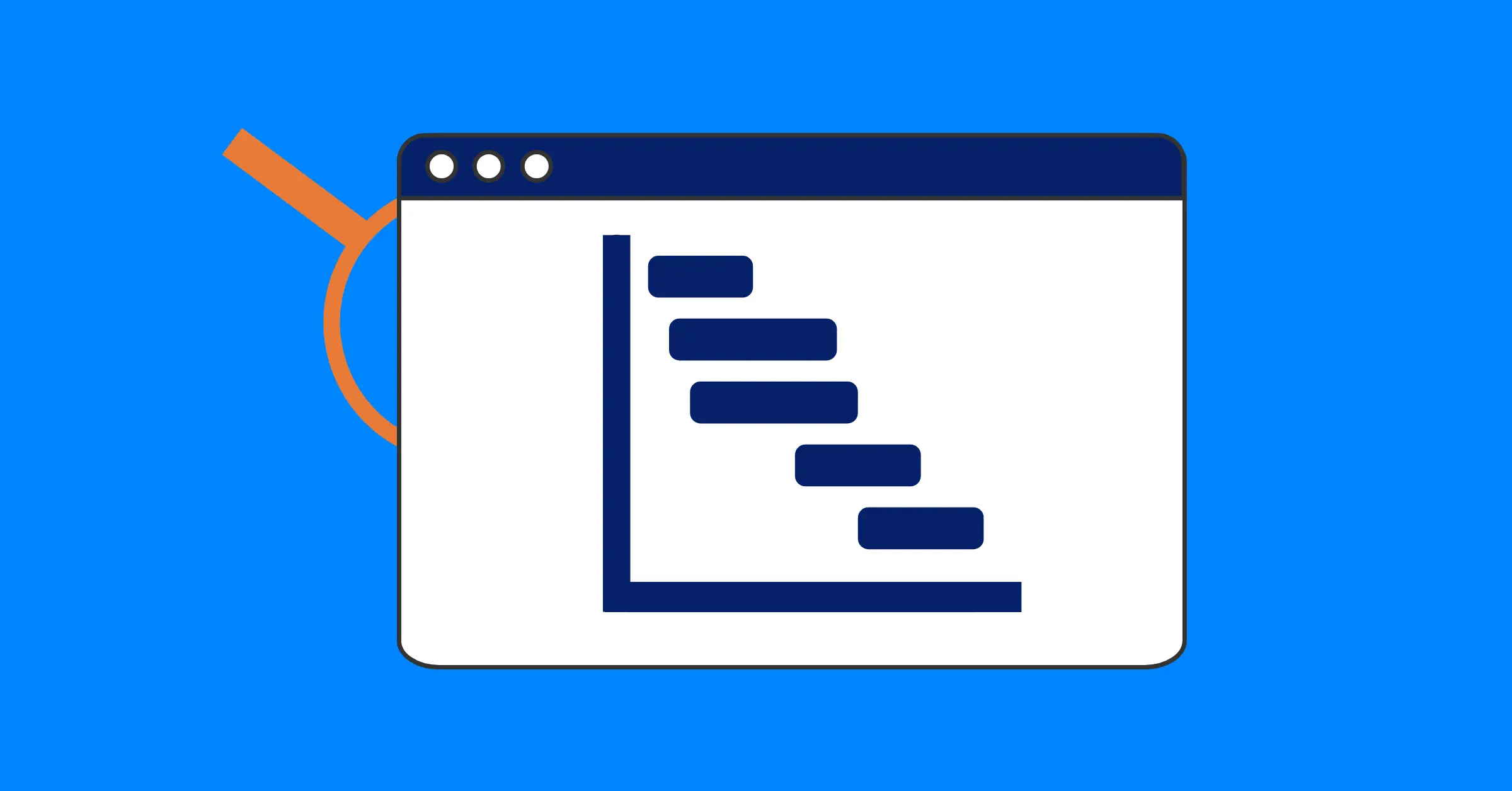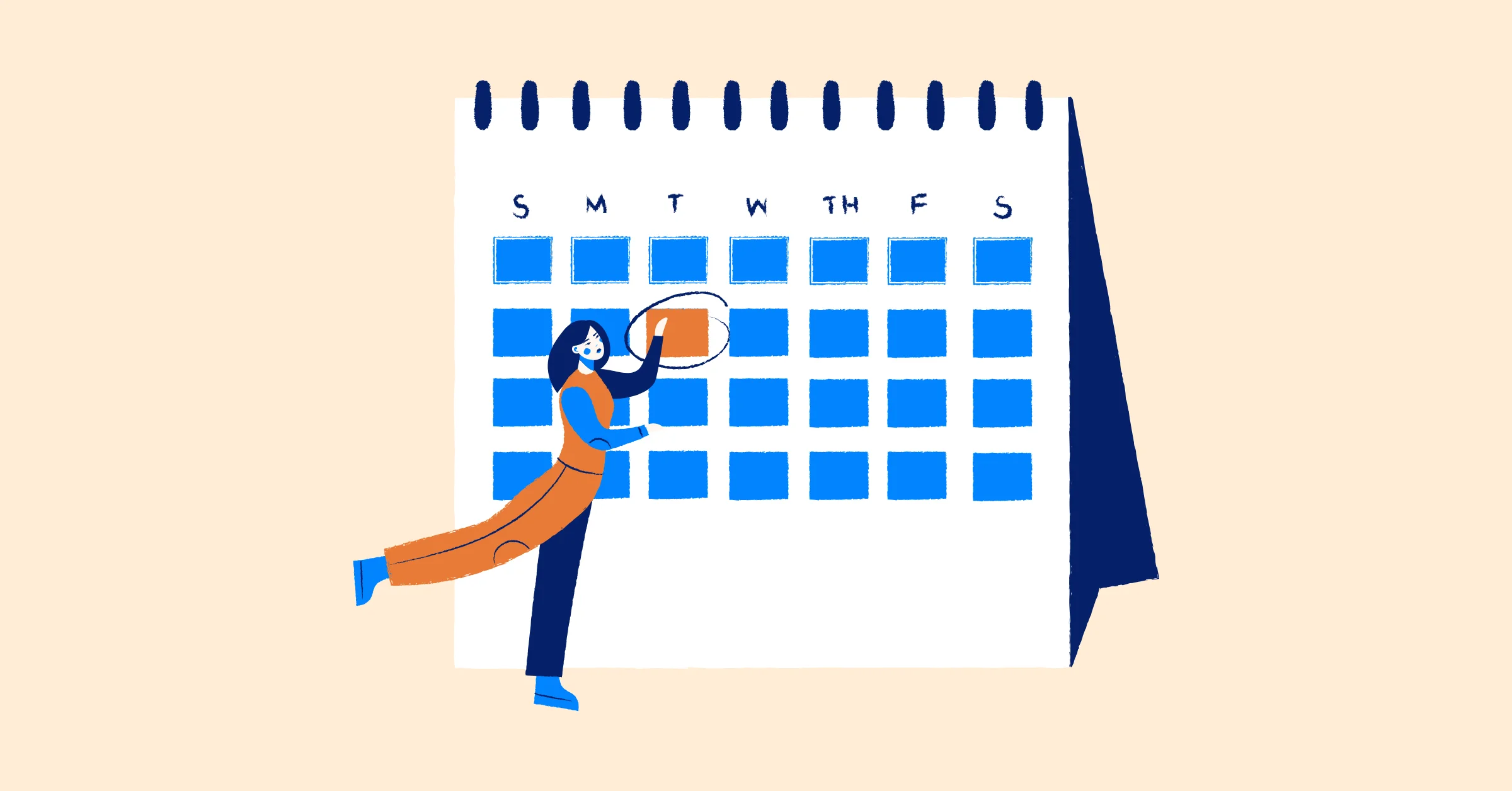Master Project Procurement Management in 5 Steps [Download a free plan template]
Master project procurement management in 5 steps with practical tips and a free template. Optimize supplier selection and contract management for project success.
Project procurement management is a critical component of successful project delivery. It involves acquiring the goods, services, or resources needed to meet project goals while balancing cost, quality, and time constraints. Whether you're managing a construction project, an IT implementation, or a product development initiative, effective procurement ensures your project stays on track. This article outlines five practical steps to master project procurement management, offering actionable insights for project managers aiming to optimize their processes. As a bonus, you can download our free procurement management plan template to streamline your process. Follow these five steps to take control of your project’s procurement and achieve better outcomes.
What Is Project Procurement Management?
Definition
Before diving into the steps, let’s clarify what project procurement management entails. It’s the process of identifying, acquiring, and managing external resources or services required for a project. This includes planning what to procure, selecting suppliers, negotiating contracts, monitoring performance, and closing agreements. According to the Project Management Institute’s PMBOK, procurement management is one of the key knowledge areas in project management, ensuring resources align with project objectives.
This article addresses those needs by breaking down the process into five clear steps, incorporating best practices and tools to help you succeed.
Why Project Procurement Management Matters
Effective procurement management directly impacts project success. By securing the right resources at the right time and cost, you ensure your project meets its objectives. It also builds strong supplier relationships, which can benefit future projects. For a deeper understanding of how procurement fits into the broader discipline, explore our article on What is Project Management.
Step 1: Develop a Procurement Management Plan
Why Planning Matters
A solid procurement management plan is the foundation of successful procurement. It outlines what you need to procure, how you’ll acquire it, and how you’ll manage suppliers. Without a plan, you risk delays, cost overruns, or misaligned resources.
How to Create the Plan
Start by reviewing your project scope and requirements. Identify which goods or services must be sourced externally versus those you can handle in-house (a “make-or-buy” decision). For example, if your project involves building a website, you might decide to outsource web development but handle content creation internally.
Next, document the following in your plan:
- Procurement Needs: List specific items or services, such as software, equipment, or consulting.
- Budget: Define cost constraints to guide vendor selection.
- Timeline: Set deadlines for procurement activities to align with the project schedule.
- Criteria for Suppliers: Establish standards for evaluating vendors, such as experience, cost, or delivery speed.
- Contract Types: Decide whether to use fixed-price, cost-reimbursable, or time-and-materials contracts based on project needs.
Practical Tip
Tools like TaskFord, Microsoft Project, or Trello can help organize your plan and track progress. Regularly review and update the plan to account for changes in project scope or market conditions.
Free Procurement Management Plan for Download
Download Resource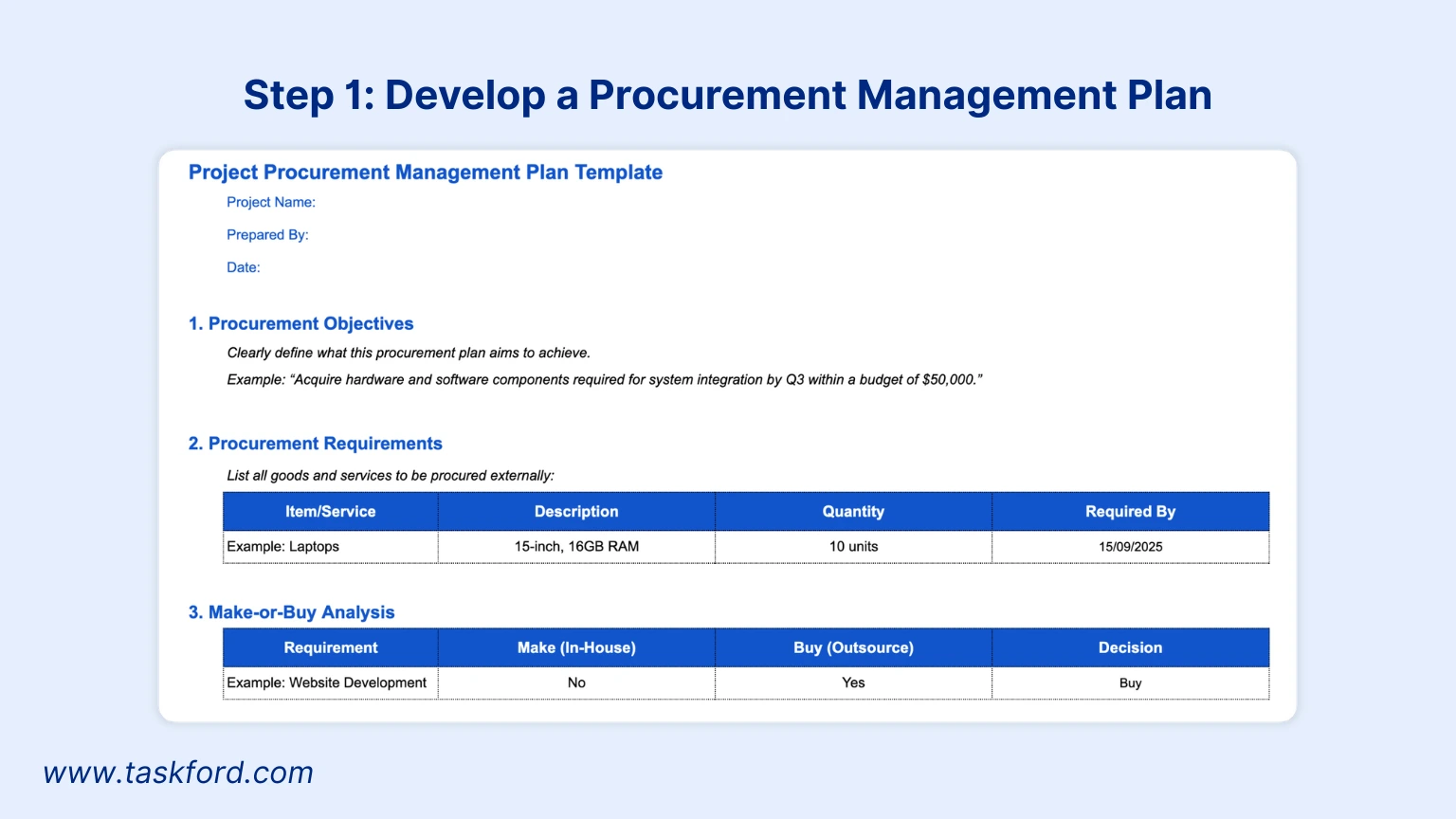
Step 2: Identify and Select Suppliers
Finding the Right Vendors
Once your plan is in place, the next step is to find and select reliable suppliers. This process, known as conducting procurements, involves sourcing vendors, requesting proposals, and evaluating bids.
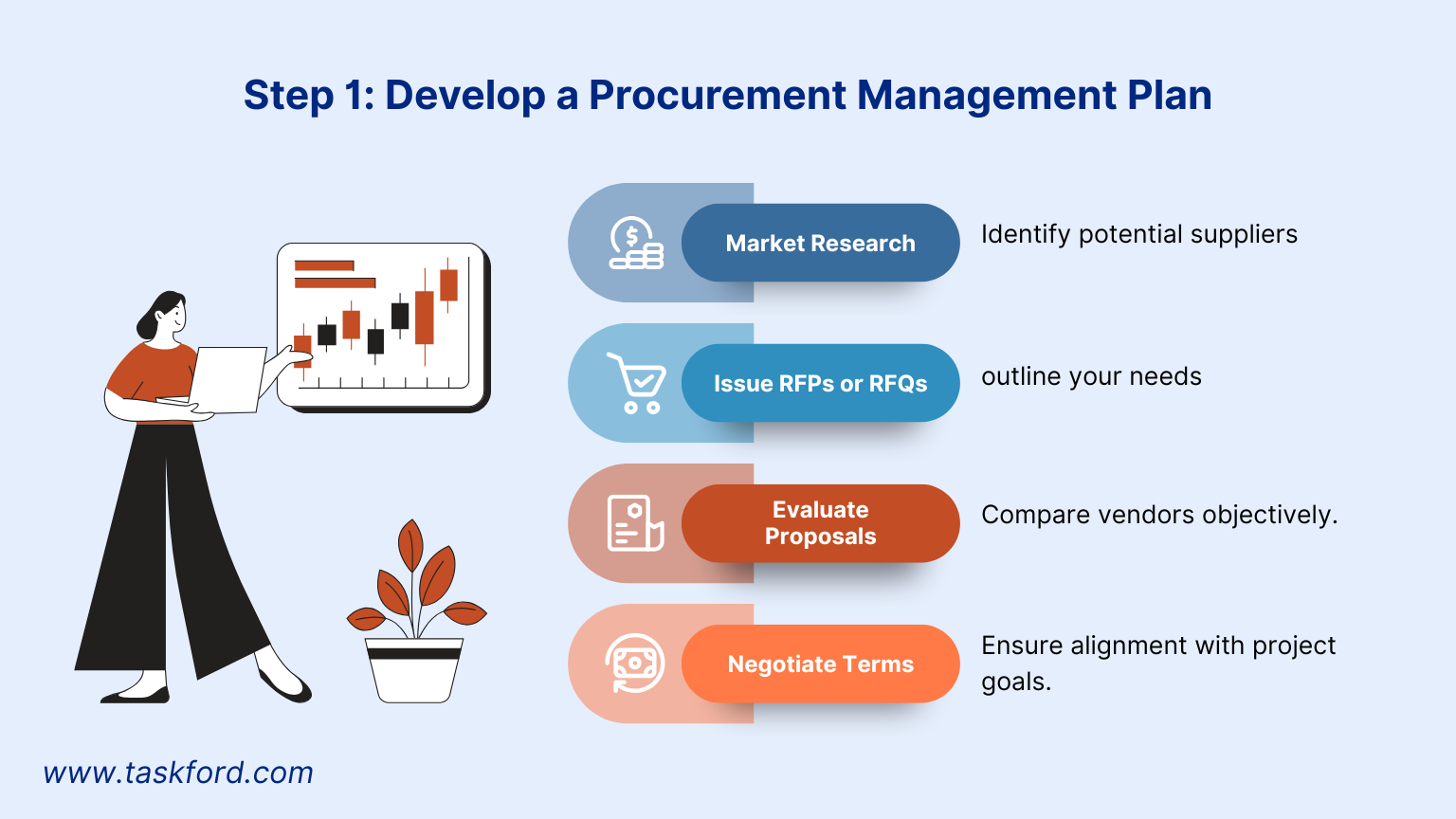
Steps to Select Suppliers
- Market Research: Identify potential suppliers through industry directories, recommendations, or online platforms like LinkedIn or procurement marketplaces.
- Issue RFPs or RFQs: Create a Request for Proposal (RFP) or Request for Quote (RFQ) to outline your needs. Include detailed specifications, deadlines, and evaluation criteria.
- Evaluate Proposals: Assess bids based on cost, quality, delivery timelines, and supplier reputation. Use a weighted scoring system to compare vendors objectively.
- Negotiate Terms: Discuss pricing, delivery schedules, and contract terms to ensure alignment with project goals.
Practical Tip
Always request references from potential suppliers and verify their track record. For example, in a construction project, confirm that a supplier has delivered materials on time for similar projects. This reduces the risk of delays or quality issues.
Learn more: Top Picks For The Best Construction Project Management Software 2025
Step 3: Negotiate and Manage Contracts
Crafting Effective Contracts
Contracts formalize agreements with suppliers, defining expectations and protecting both parties. A well-structured contract minimizes disputes and ensures clarity.
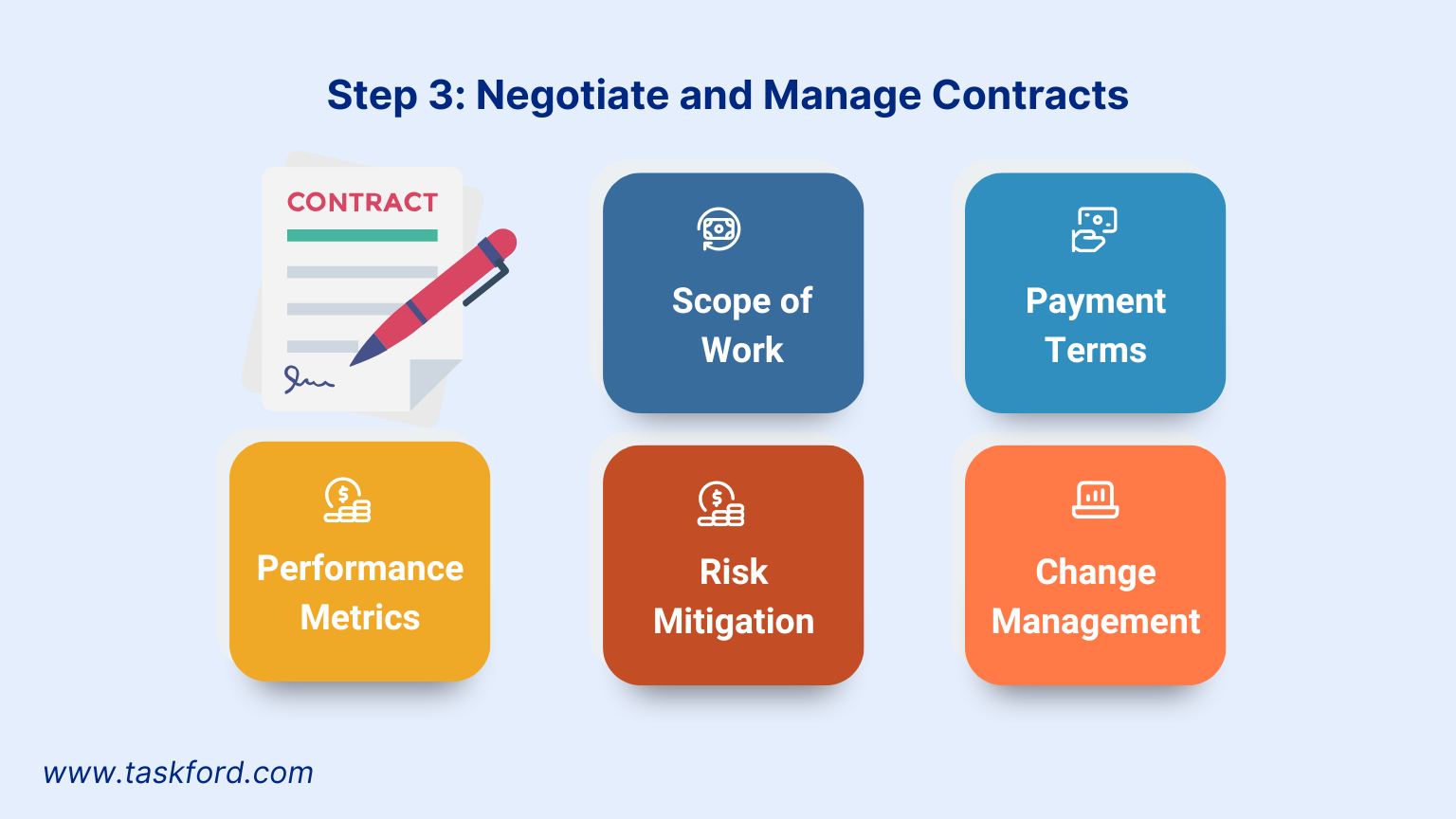
Key Elements of a Contract
- Scope of Work: Clearly define deliverables, including specifications and deadlines.
- Payment Terms: Specify costs, payment schedules, and penalties for late delivery.
- Performance Metrics: Include measurable standards, such as quality benchmarks or delivery timelines.
- Risk Mitigation: Address potential issues, like delays or defective goods, with clauses for remedies or termination.
- Change Management: Outline how changes to scope or terms will be handled.
Managing Contracts
Once signed, actively manage the contract to ensure compliance. Use project management software to track deliverables, monitor payments, and communicate with suppliers. Regular check-ins with vendors can help address issues early.
Practical Tip
For complex projects, consider involving a legal expert to review contracts. This ensures compliance with regulations and protects your project from unforeseen liabilities.
Step 4: Monitor and Control Procurement Processes
Why Monitoring Is Critical
Procurement doesn’t end with signing a contract. Ongoing oversight ensures suppliers meet expectations and the project stays on track. This step, known as controlling procurements, involves tracking performance, managing risks, and handling changes.
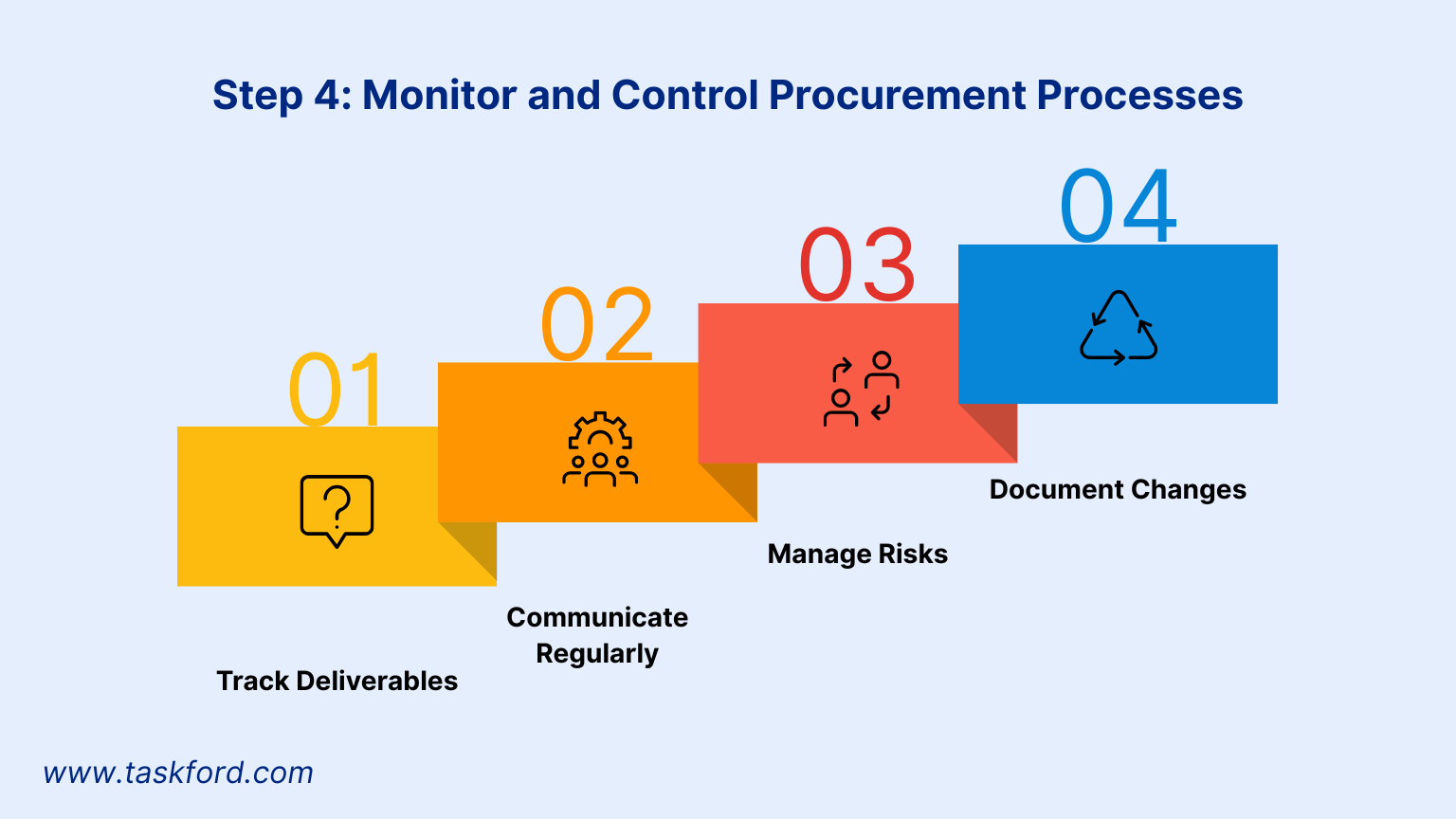
How to Monitor Effectively
- Track Deliverables: Use a checklist to verify that goods or services meet specifications. For example, if you’re procuring software, test it against requirements before full deployment.
- Communicate Regularly: Schedule status updates with suppliers to discuss progress and address concerns.
- Manage Risks: Identify potential issues, such as supplier delays or cost overruns, and have contingency plans in place.
- Document Changes: If project requirements change, update contracts and communicate adjustments to suppliers.
Practical Tip
Use key performance indicators (KPIs) to evaluate supplier performance. Common KPIs include on-time delivery rate, defect rate, and adherence to budget.
Step 5: Close Procurements and Evaluate Performance
Finalizing Procurement
Closing procurements ensures all obligations are met and lessons are captured for future projects. This step involves verifying deliverables, settling payments, and documenting outcomes.
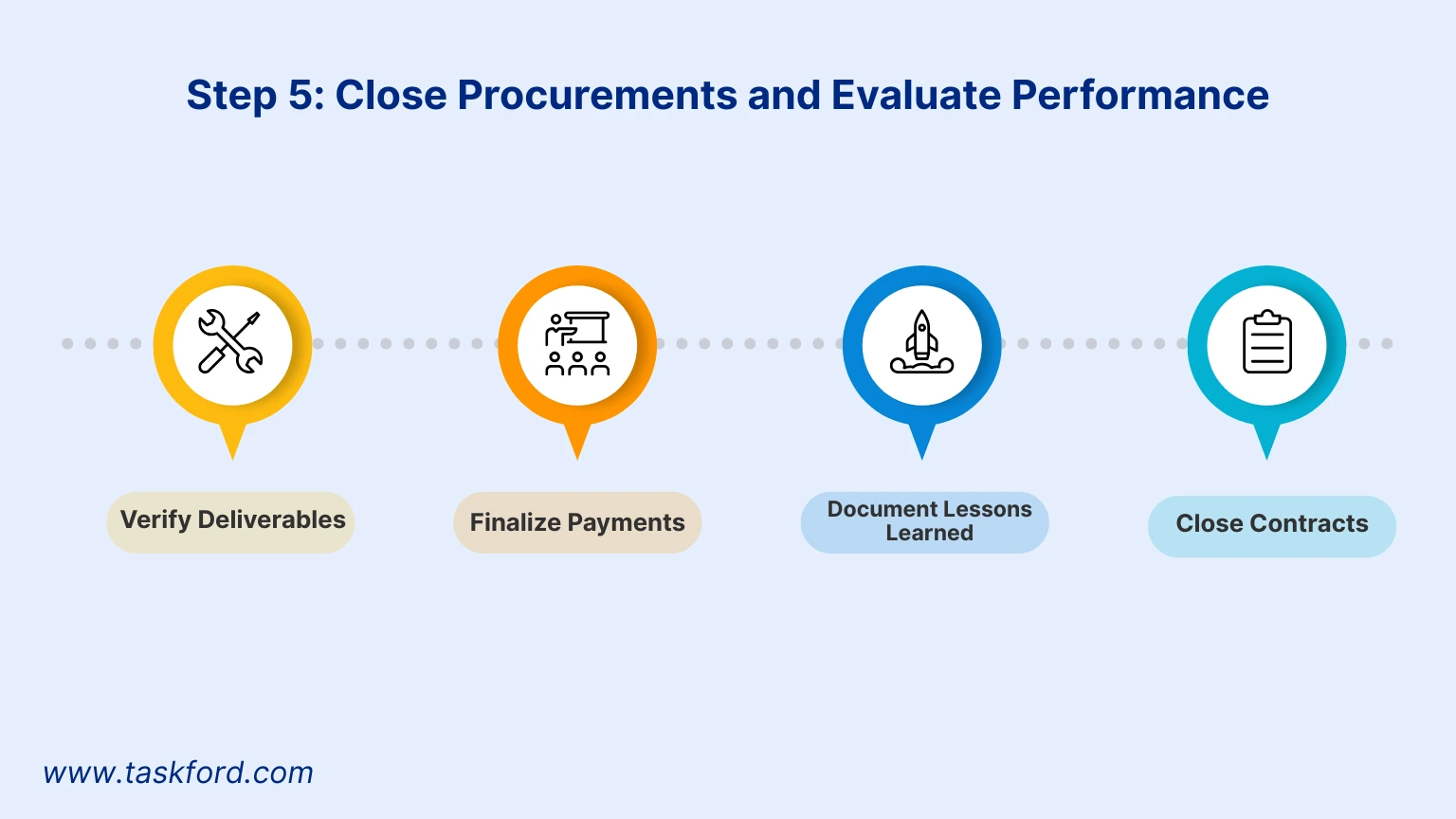
Steps to Close Procurements
- Verify Deliverables: Confirm that all goods or services meet the agreed-upon standards.
- Finalize Payments: Process final invoices and ensure all financial obligations are complete.
- Document Lessons Learned: Record what worked well and what didn’t to improve future procurements.
- Close Contracts: Formally terminate agreements, ensuring all terms are fulfilled.
Evaluating Performance
Conduct a post-procurement review to assess supplier performance and the effectiveness of your procurement process. Ask questions like:
- Did the supplier meet deadlines and quality standards?
- Were there unexpected costs or delays?
- How can the process be improved for the next project?
Practical Tip
Create a procurement closure checklist to ensure no steps are missed. Share feedback with suppliers to foster stronger relationships for future collaborations.
Common Challenges & Tools for Project Procurement Management
Common Challenges
Even with a solid process, challenges can arise. Here are some common issues and how to address them:
- Supplier Delays: Mitigate by including penalty clauses in contracts and maintaining a backup supplier list.
- Cost Overruns: Set clear budgets in the procurement plan and monitor spending closely.
- Quality Issues: Conduct thorough vendor evaluations and include quality assurance steps in contracts.
- Regulatory Compliance: Stay informed about industry-specific regulations, especially for government or international projects.
Tools to Streamline Project Procurement Management
Several tools can simplify procurement tasks:
- Procurement Software: Platforms like Coupa or SAP Ariba help manage vendor relationships and track spending.
- Project Management Tools: Tools like TaskFord, Trello, Asana, or Microsoft Project integrate procurement tasks into your broader project plan.
- Templates: Use RFP, RFQ, or contract templates from trusted sources to save time.
Conclusion
Mastering project procurement management requires careful planning, supplier selection, contract management, ongoing monitoring, and thorough closure. By following these five steps - developing a plan, selecting suppliers, managing contracts, controlling processes, and closing procurements- you can streamline your approach and avoid common pitfalls. Use the practical tips and tools outlined here to enhance your procurement process and leverage resources like templates or software to save time. With these strategies, you’ll be well-equipped to deliver successful projects while optimizing resources and minimizing risks.
Making work simpler,
smarter, and more connected
Join our waitlist and be notified first.

Related Blog
Subscribe for Expert Tips
Unlock expert insights and stay ahead with TaskFord. Sign up now to receive valuable tips, strategies, and updates directly in your inbox.


